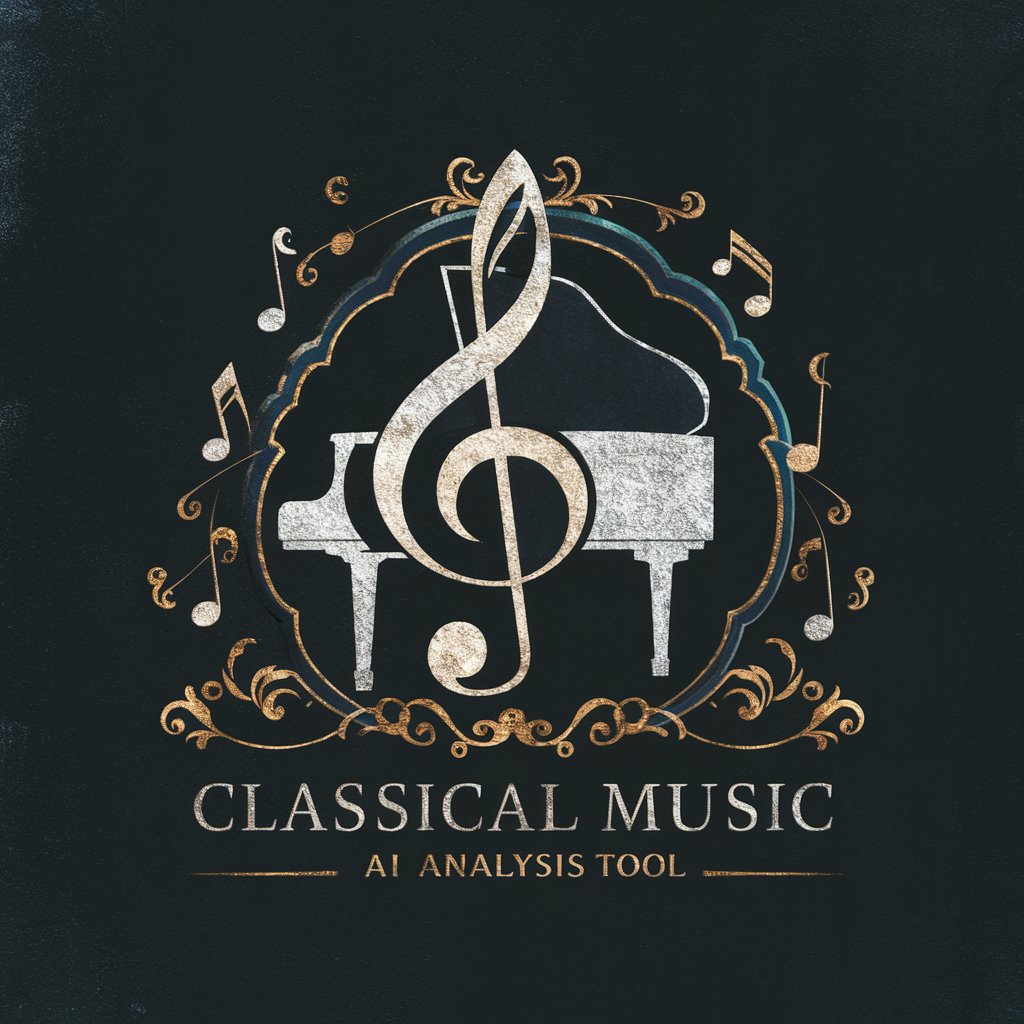Classical Music Analysis - Classical Music Insights

Welcome to the Classical Music Analysis Tool!
Decoding Classics with AI
Analyze the harmonic structure of Beethoven's Symphony No. 9.
Explain the historical context of Tchaikovsky's Swan Lake.
Describe the use of counterpoint in Bach's The Art of Fugue.
Discuss the thematic development in Mozart's Symphony No. 40.
Get Embed Code
Introduction to Classical Music Analysis
Classical Music Analysis is designed as a comprehensive AI tool aimed at deepening the understanding of classical music compositions through detailed analysis of theory, composition techniques, and historical context. It serves as a bridge between complex musical concepts and enthusiasts seeking to understand or analyze classical music more profoundly. For example, when studying a Beethoven symphony, Classical Music Analysis can dissect the work's thematic development, harmonic progression, and its place within the broader context of the Romantic period, highlighting Beethoven's innovative use of motifs and his impact on the music that followed. Powered by ChatGPT-4o。

Core Functions of Classical Music Analysis
Theoretical Analysis
Example
Exploring the harmonic structure of a Chopin nocturne, including chord progressions and modulations.
Scenario
A music theory student uses this function to understand the underlying harmonic framework of Chopin's work for a term paper, utilizing the analysis to illustrate Chopin's innovative approach to romantic harmony.
Composition Techniques
Example
Analyzing the counterpoint techniques in Bach's 'The Art of Fugue'.
Scenario
A composer studies the intricate counterpoint of Bach to inspire and inform their own compositions, seeking to incorporate Baroque elements into a contemporary piece.
Historical Contextualization
Example
Examining the influence of Mozart's operas on classical music and society during the Enlightenment.
Scenario
An enthusiast attends a lecture series on classical music history and uses the tool to prepare, gaining insights into how Mozart's compositions reflected and influenced the cultural and philosophical shifts of his time.
Target User Groups for Classical Music Analysis
Music Theory Students
Students studying music theory can leverage detailed analyses of compositions to understand complex musical concepts, aiding in their academic pursuits and providing concrete examples for their studies.
Composers and Musicians
Composers and musicians benefit from insights into composition techniques and historical context, enhancing their creative process and deepening their interpretative approaches to performance.
Classical Music Enthusiasts
Enthusiasts eager to explore the depths of classical music can find rich, accessible explanations and analyses, making the vast world of classical compositions more approachable and enjoyable.

Using Classical Music Analysis
1
Visit yeschat.ai for a complimentary trial, no sign-up or ChatGPT Plus required.
2
Choose your focus area from options such as composition analysis, theory explanation, or historical context.
3
Upload or describe the piece of classical music you're interested in analyzing.
4
Specify any particular elements you're curious about, such as harmony, structure, or composer's intent.
5
Review the generated analysis, and feel free to ask follow-up questions or request clarification on any points of interest.
Try other advanced and practical GPTs
Shoggoth
Unveil the future with AI in Lovecraftian style

Half Twain The Jesse meaning?
Unleash Creativity with AI

ML Professor for General Software Engineers
Empowering Engineers with AI Insights

Gen Z Money Buddy
AI-Powered Finance Buddy for Gen Z

宠物狗医疗咨询GPT
Expert AI Health Companion for Dogs

MonsterGPT
Bringing Fantasy to Life with AI

VidScript Creator 🎥
Craft Captivating Scripts with AI

Style Crafter
AI-powered fashion accessory design

Wanderführer | Hiking Guide
Explore Trails with AI

Web3 Creative Advisor
Empowering Creatives in Web3

Språkprofil Oslo kommune (uoffisiell)
Enhancing Clarity with AI

Enamored Glass
Unravel the Past with AI-Powered Glass Insights

FAQs on Classical Music Analysis
What types of music can Classical Music Analysis handle?
This tool is specialized in classical music from all periods, including Baroque, Classical, Romantic, and contemporary classical compositions.
Can it analyze any composer's work?
Yes, it can analyze works from a wide range of composers, from Bach and Beethoven to contemporary composers, provided there is sufficient information or score available for analysis.
Does this tool help with music theory homework?
Absolutely, it can assist in explaining music theory concepts, analyzing compositions for assignments, and providing insights into various compositional techniques.
Is it suitable for beginners?
Yes, it's designed to cater to both beginners and advanced users, offering explanations in simple terms as well as in-depth analyses for more experienced enthusiasts.
Can it provide historical context for compositions?
Definitely, it offers insights into the historical and cultural background of compositions, helping users understand the context in which a piece was written.
